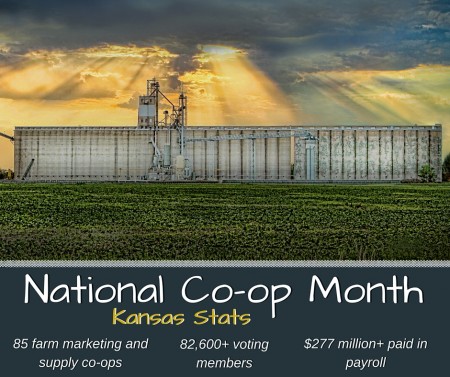Breadcrumb
- Home
- Recent news stories
- Cooperatives Invest in Kansas Agriculture

*85 total local farm marketing and supply co-ops, 61 responded to 2015 voluntary membership survey, so the above statistics represent a significant portion, but not all, of relevant statistics.
Every October since the 1930s, the American agriculture industry has joined in celebrating this mutually beneficial business model during National Co-op Month.
“Many of our cooperative members are interested in working together to strengthen their ability to provide services that their local farmer members need,” Leslie Kaufman, president and CEO of the Kansas Cooperative Council, said. “Some co-ops are looking at cutting wait times in line, so they are making investments in scales and dumping. And some are looking at providing additional crop protection services, so they are adding a new agronomic center or fertilizer plant. And some are looking at storage capacity and being able to take in more grain.”
The need for increased investment in additional services and infrastructure has also led to more discussions on how individual co-ops can partner together.
“A lot of that growth is happening at individual co-op locations, but there is also a change in dynamic where we are starting to see more discussions on how co-ops can work better together – whether that is an outright merger or forming a type of alliance,” Kaufman said.
Kaufman explained that Kansas had more than 380 farmer cooperatives in the mid-1950’s. Today, that number is estimated at less than 100. The Kansas Cooperative Council’s membership role lists 85 local farm marketing and supply co-ops. The Council annually surveys its members and of those 85 ag co-ops, 61 responded to the 2015 inquiry, reporting a combined membership total of 82,600 voting members.
The Kansas statistics mirror what is happening nationally, although Kaufman reported that the investment in Kansas has still centered around a local co-op, which is not always the case in other states. She further explained that the majority of cooperative mergers in Kansas have been with neighboring or semi-neighboring cooperatives. No matter the sizes, if true ag marketing co-ops merge, the resulting entity remains farmer-owned.
“Although the total number of Kansas ag co-ops may be dropping, the number of facilities and locations may not be declining as quickly. In many cases, merged entities continue to operate many of their local stations,” Kaufman said.
Kansas cooperatives throughout the state are building to meet the demand for increased grain storage capacity, improved efficiency in weighing and dumping time and more crop input warehouse space. Aging infrastructure is also contributing to the need for newer, updated facilities. For example, Dan O’Brien, Kansas State University agricultural economist, reported at the 2015 Risk and Profit Conference that total grain storage capacity per elevator has increased nine percent to 1.433 billion bushels in 2015, even while the total number of grain storage facilities has decreased to 687 in 2014 from 698 in 2009. Those numbers included both cooperatively-owned and independent grain handlers. However, Kaufman did note that while new construction or investment may occur within a cooperative’s service territory, the new facilities may not be located in the same location as the old, depending on the needs of the members or local zoning and building requirements.
With increased service and structural investments, Kansas cooperatives are also contributing more back to local economies in the form of taxes and wages. According to the Kansas Cooperative Council’s voluntary membership survey, the 65 responding co-ops, just a portion of all of the various types of co-ops in the state, paid $277 million in payroll and $23 million in property taxes last year, in addition to $1.3 million in charitable contributions. Those numbers demonstrate co-ops are an integral part of their local economies.
Agricultural cooperatives have adapted throughout time to meet the changing needs of their farmer member-owners. The current pace of investment in new facilities and services is a continuation of that proud tradition. After all, as Kaufman said, “Overall, there is a general awareness that you cannot stay the same forever. It is about moving forward.”
Check back each week for new stories of how farmer cooperatives are investing in the Kansas grain industry, benefiting their farmer owners and contributing to the reliability, quality and value of the Kansas wheat crop each year.
